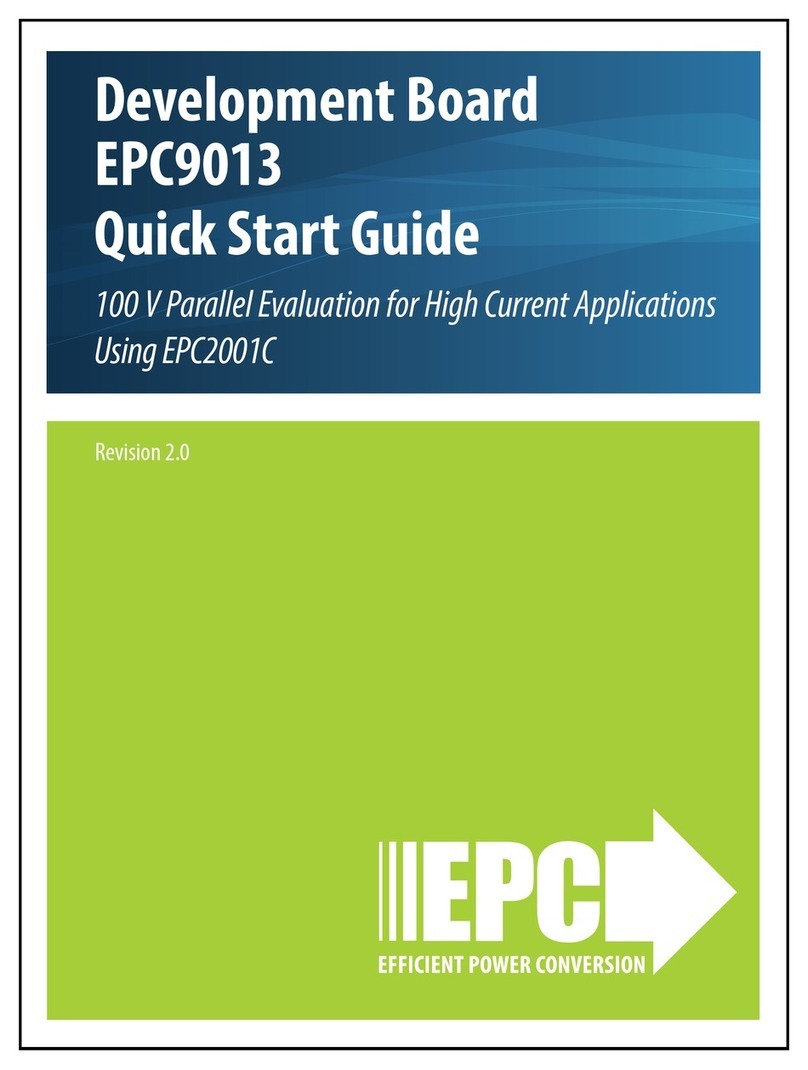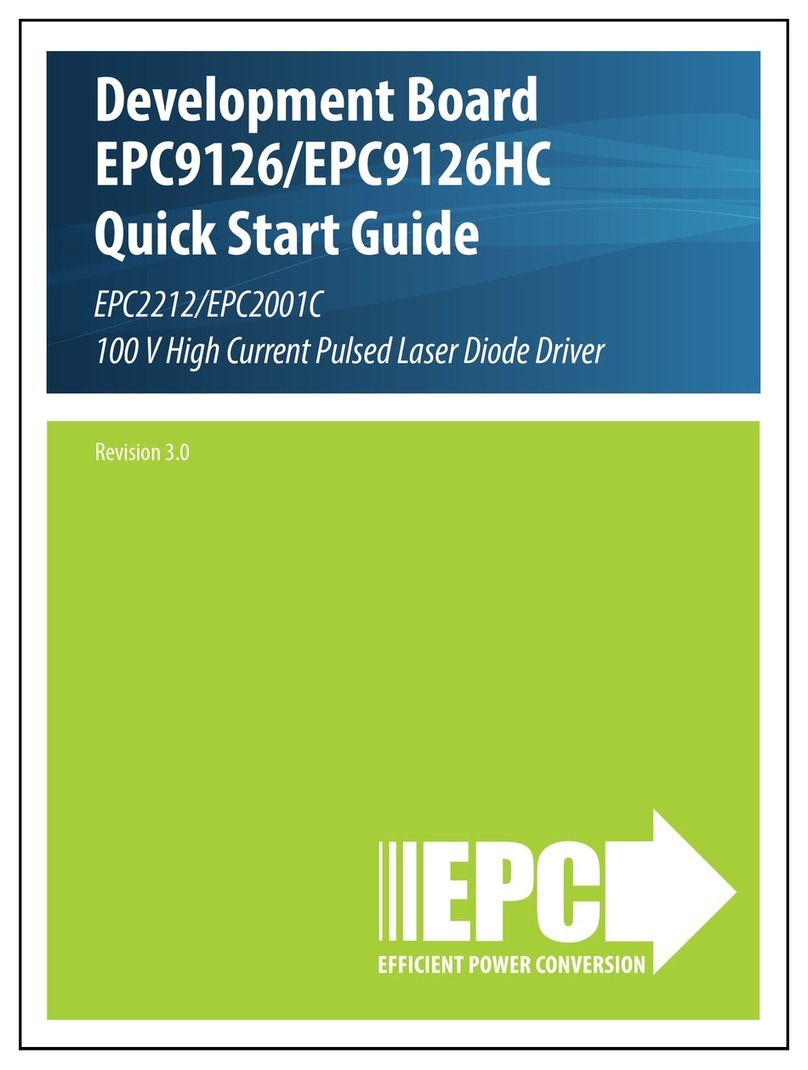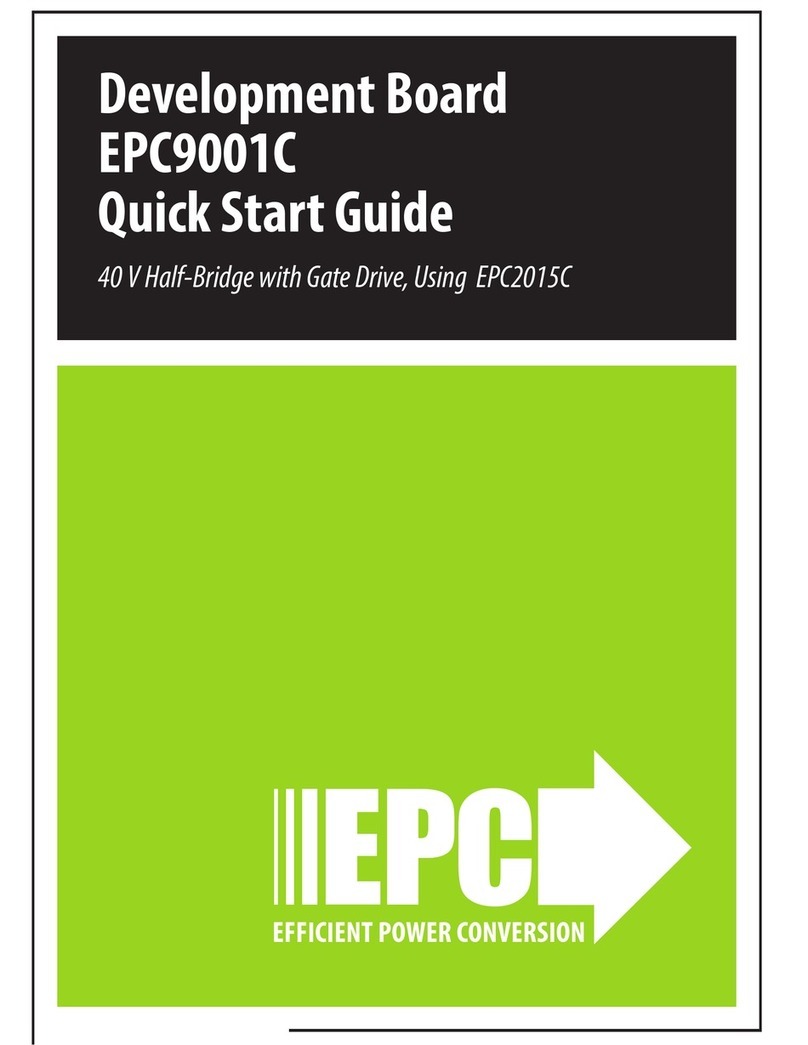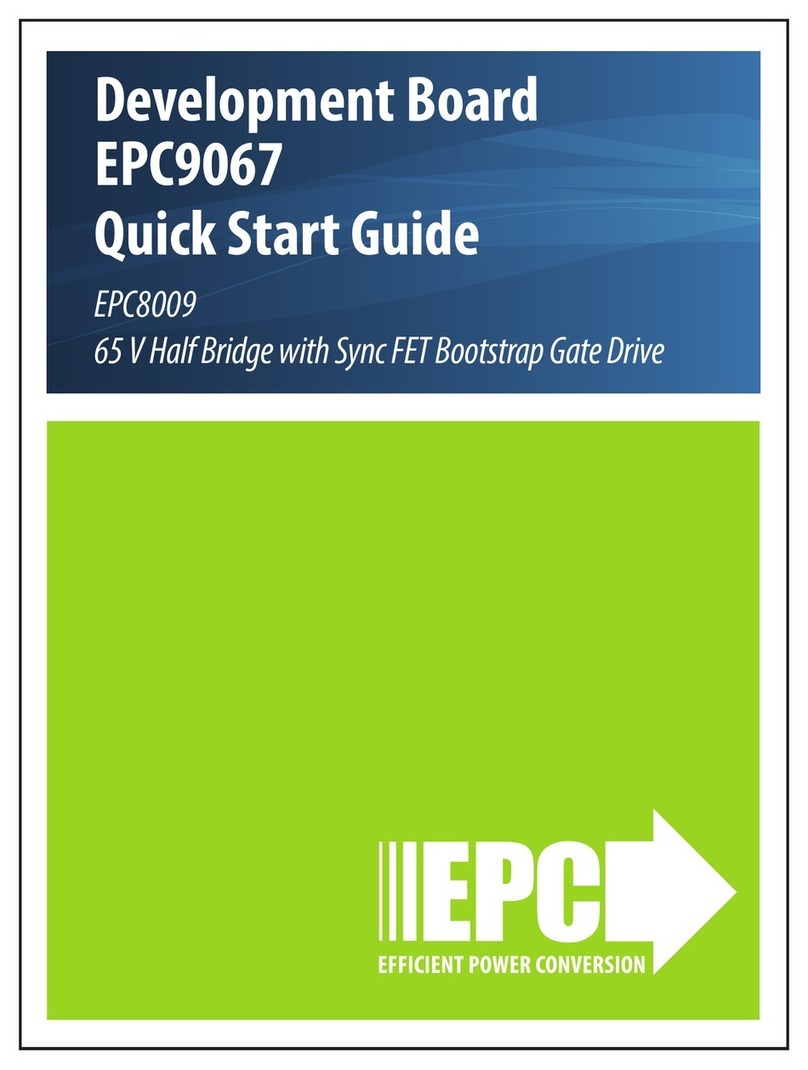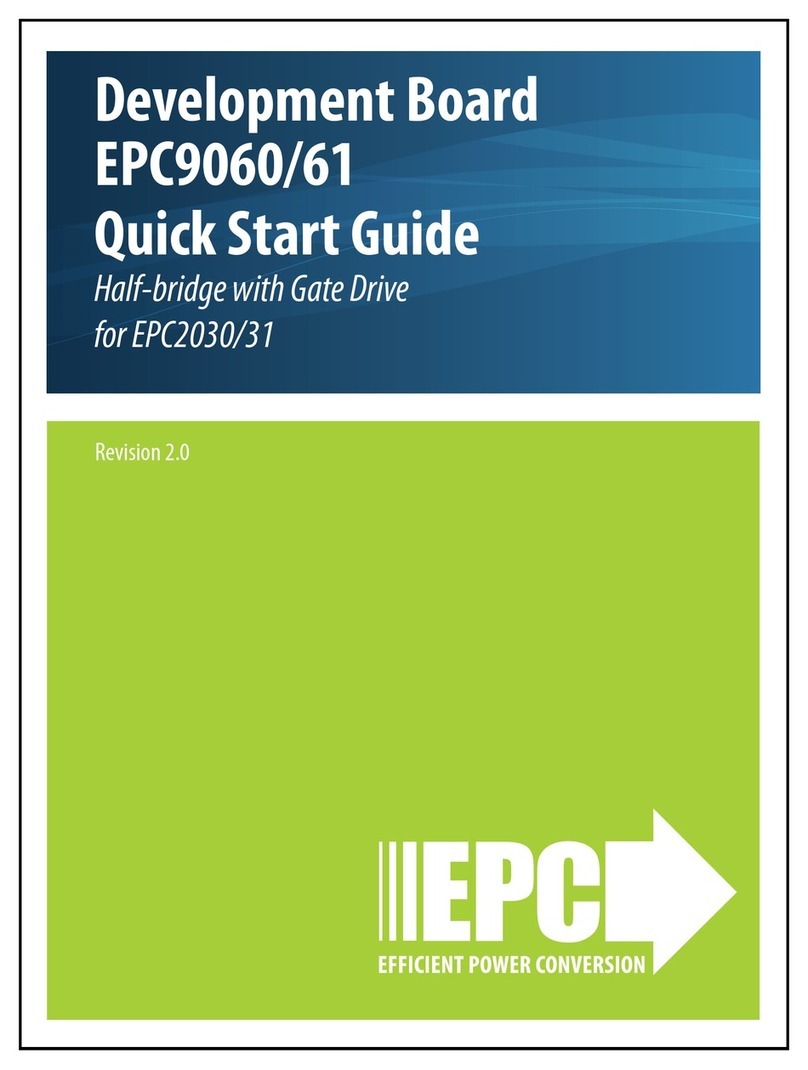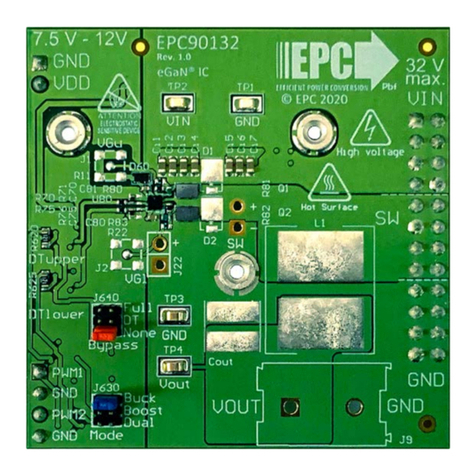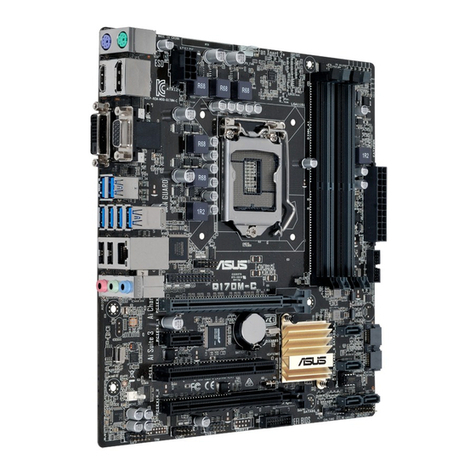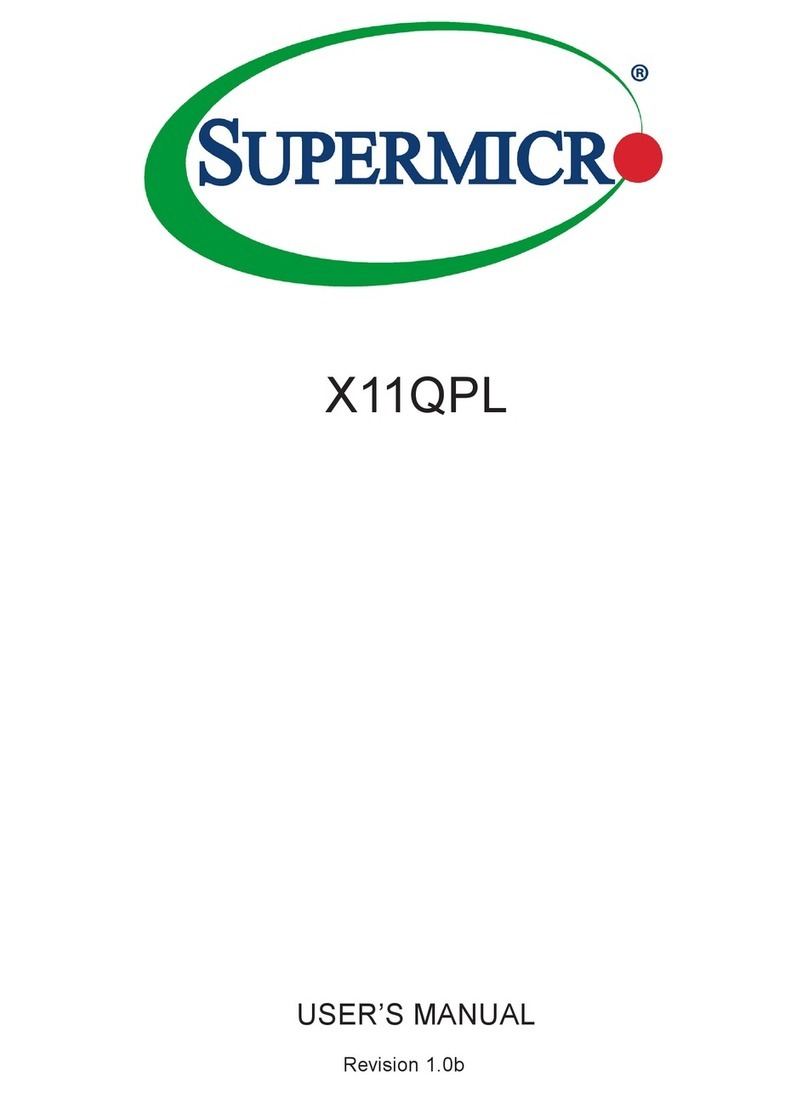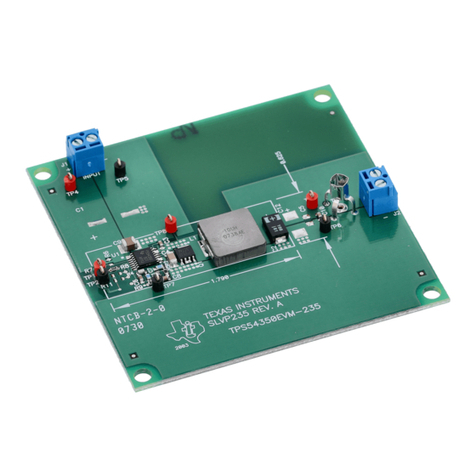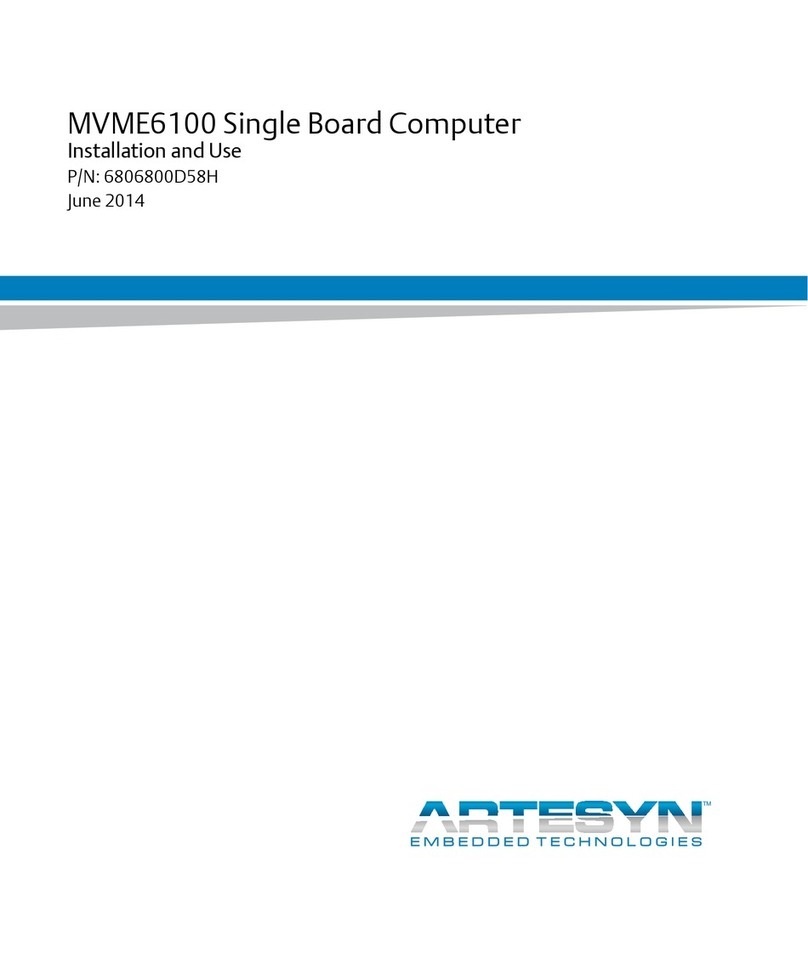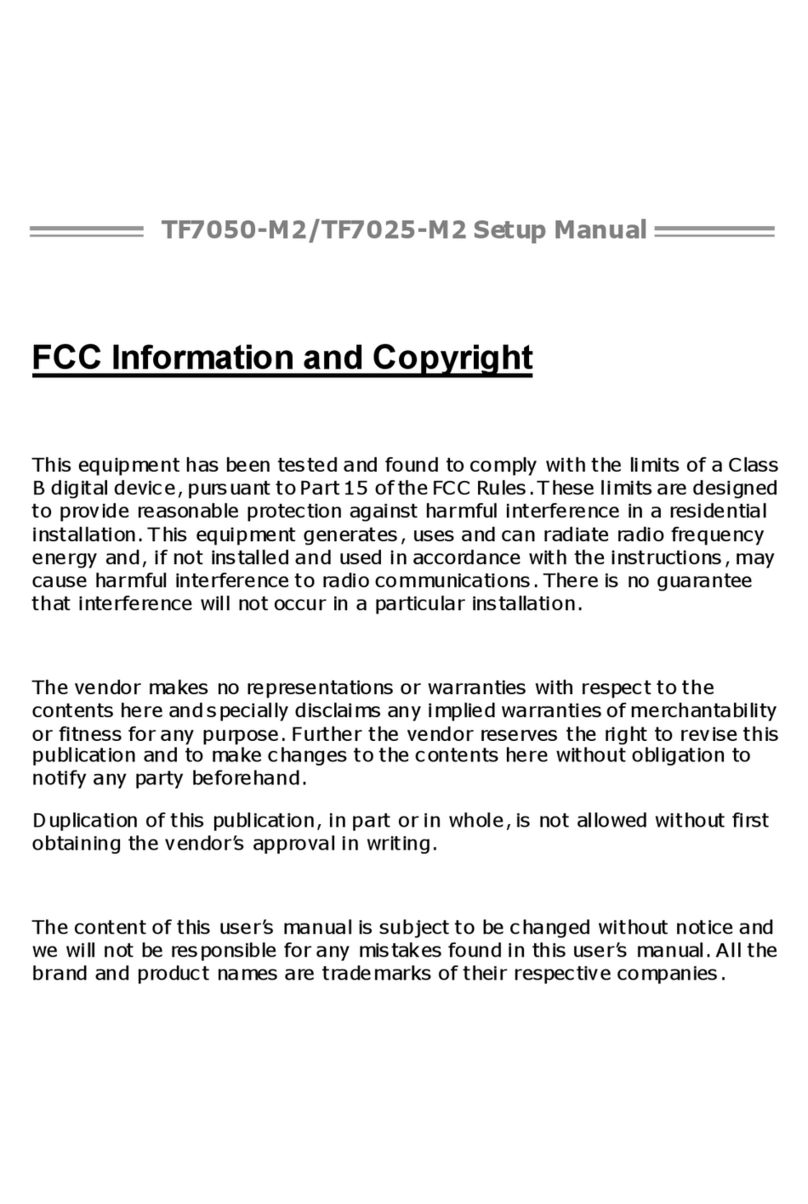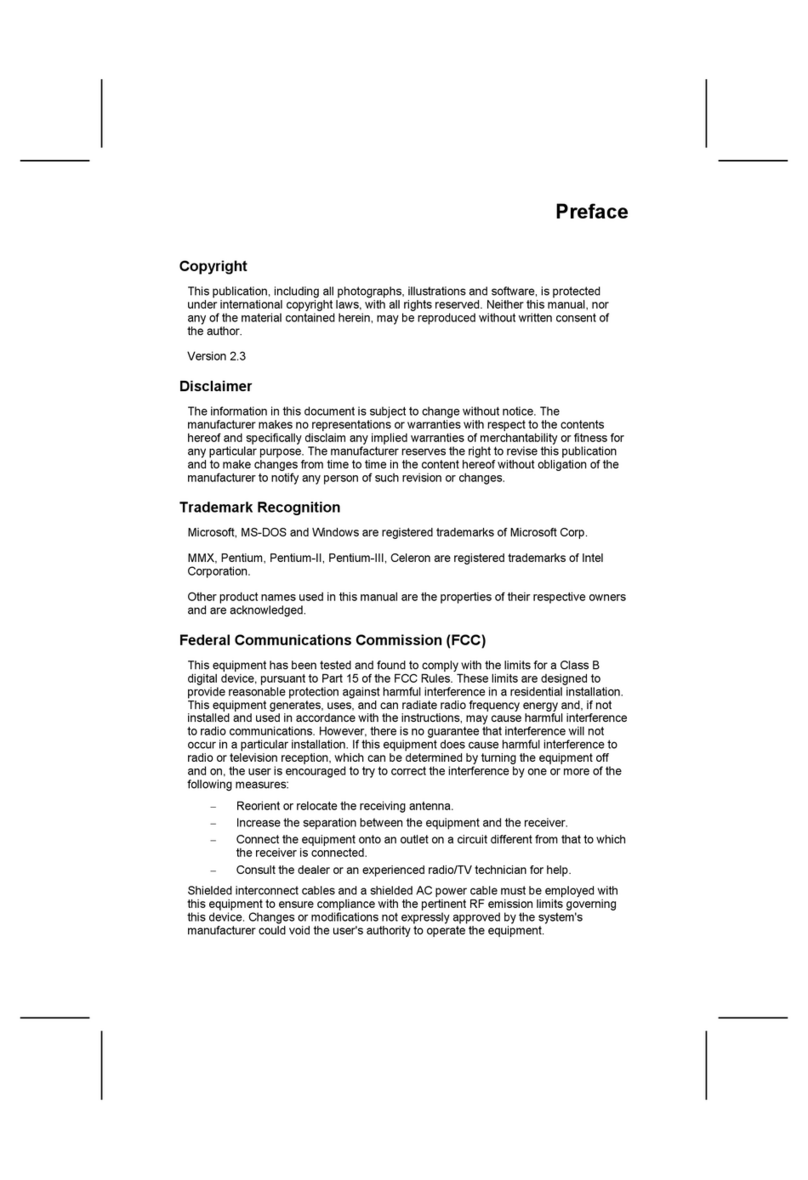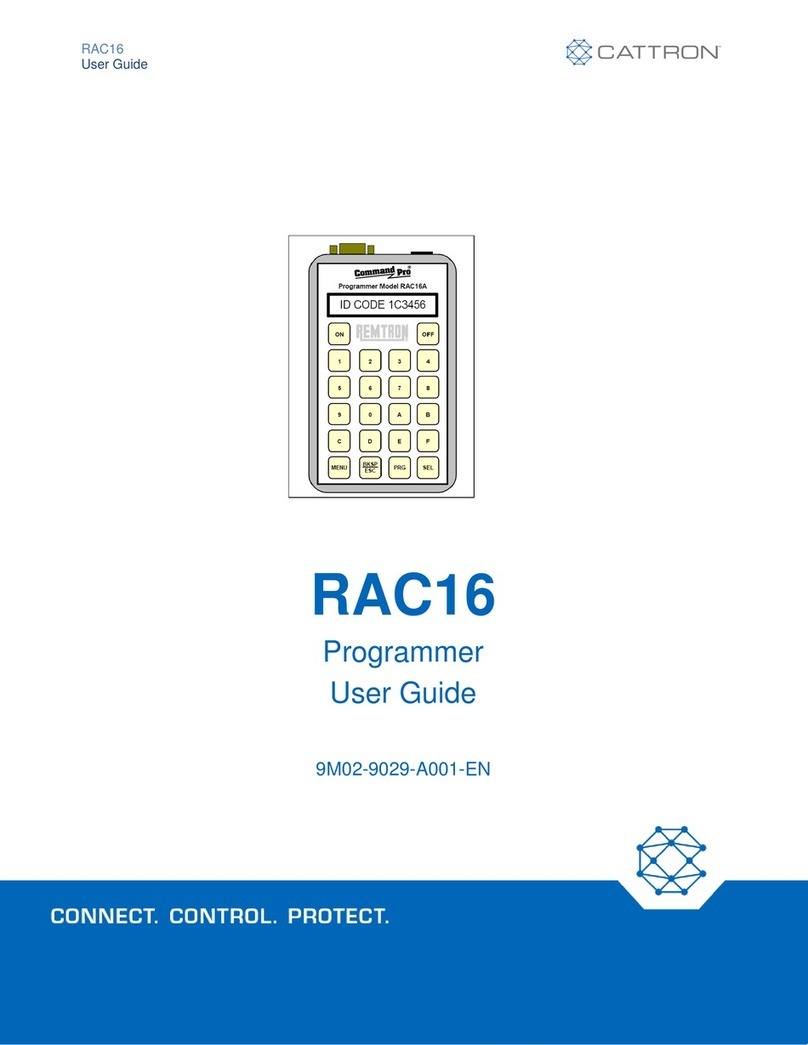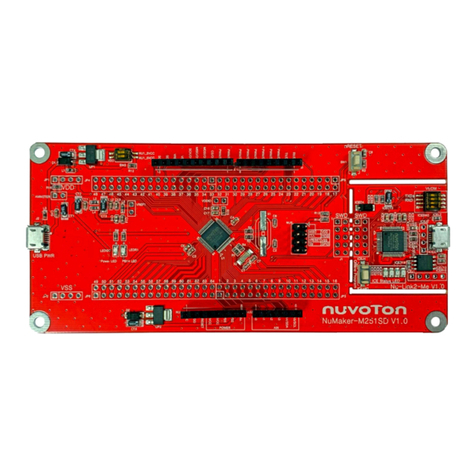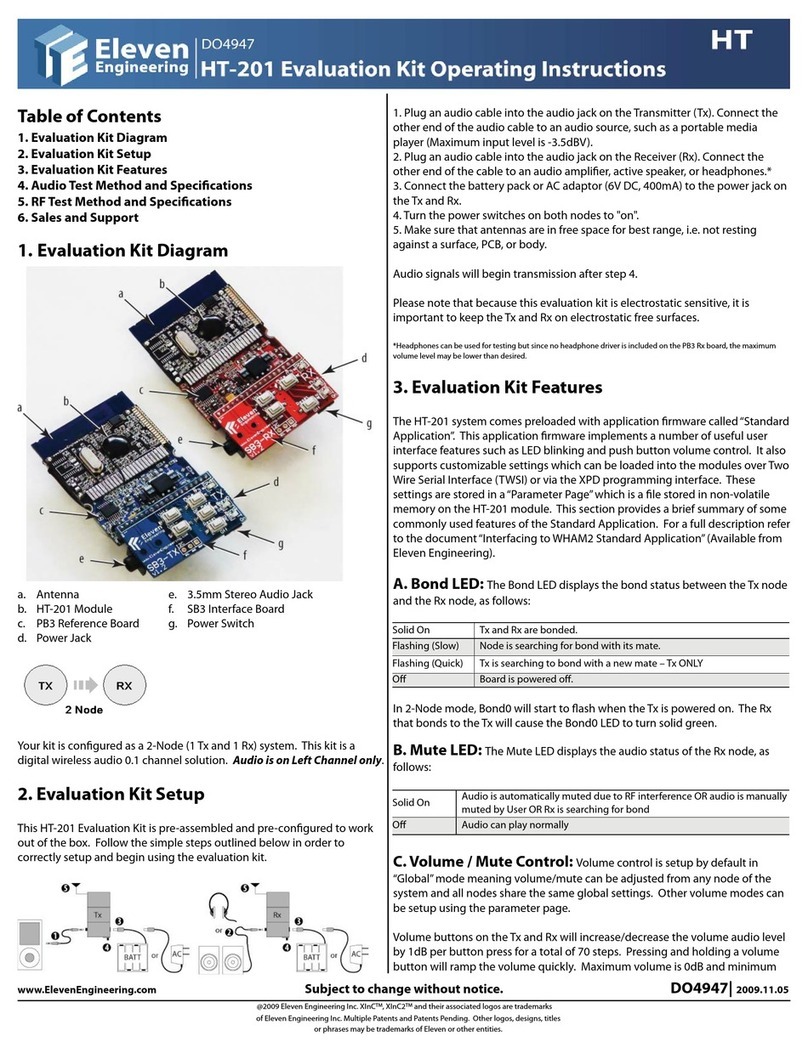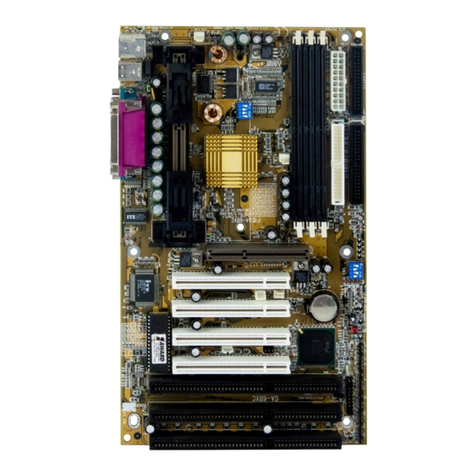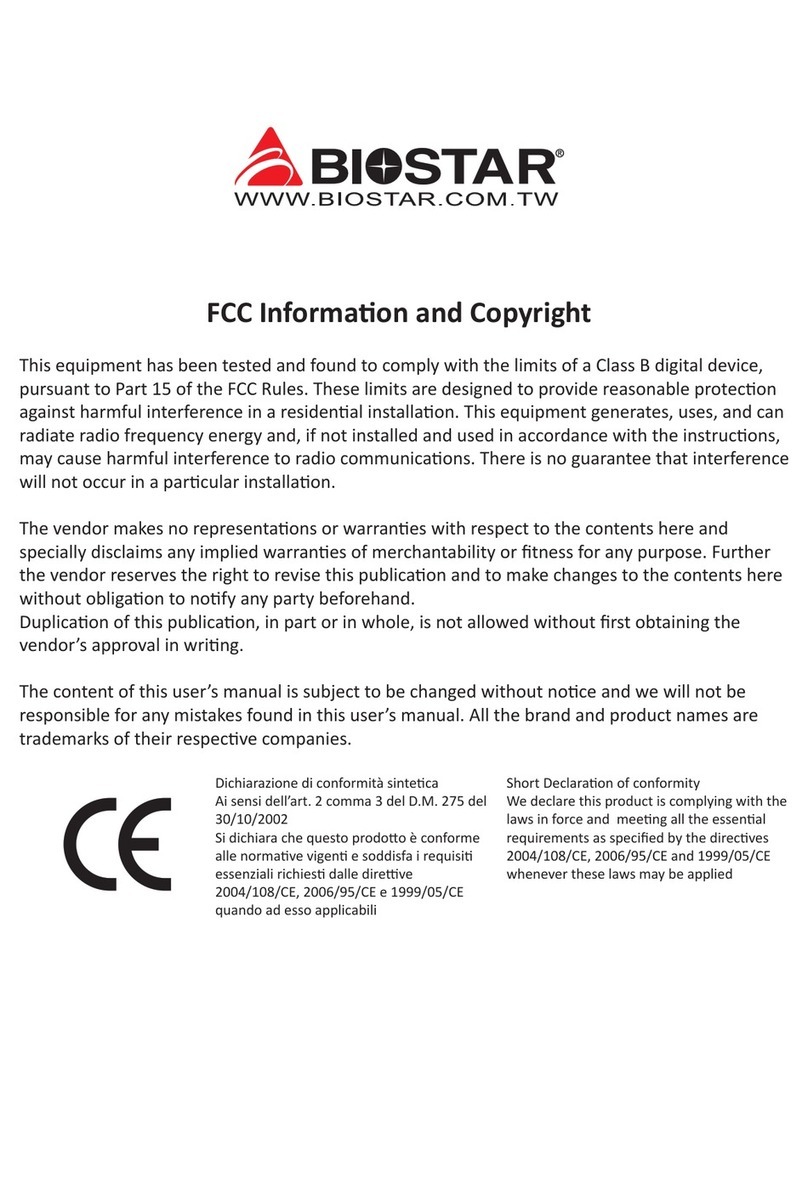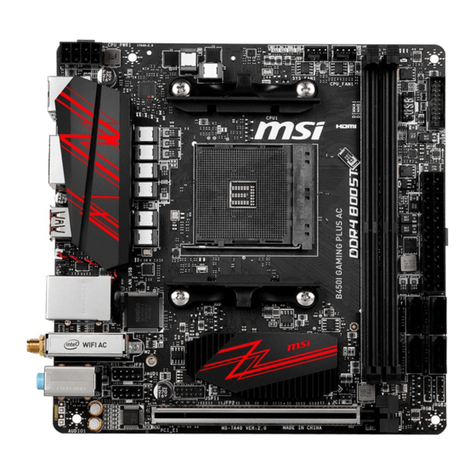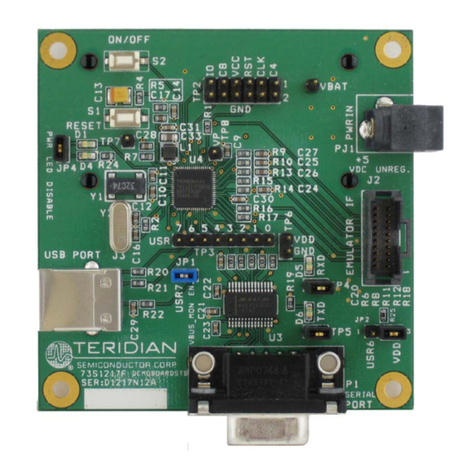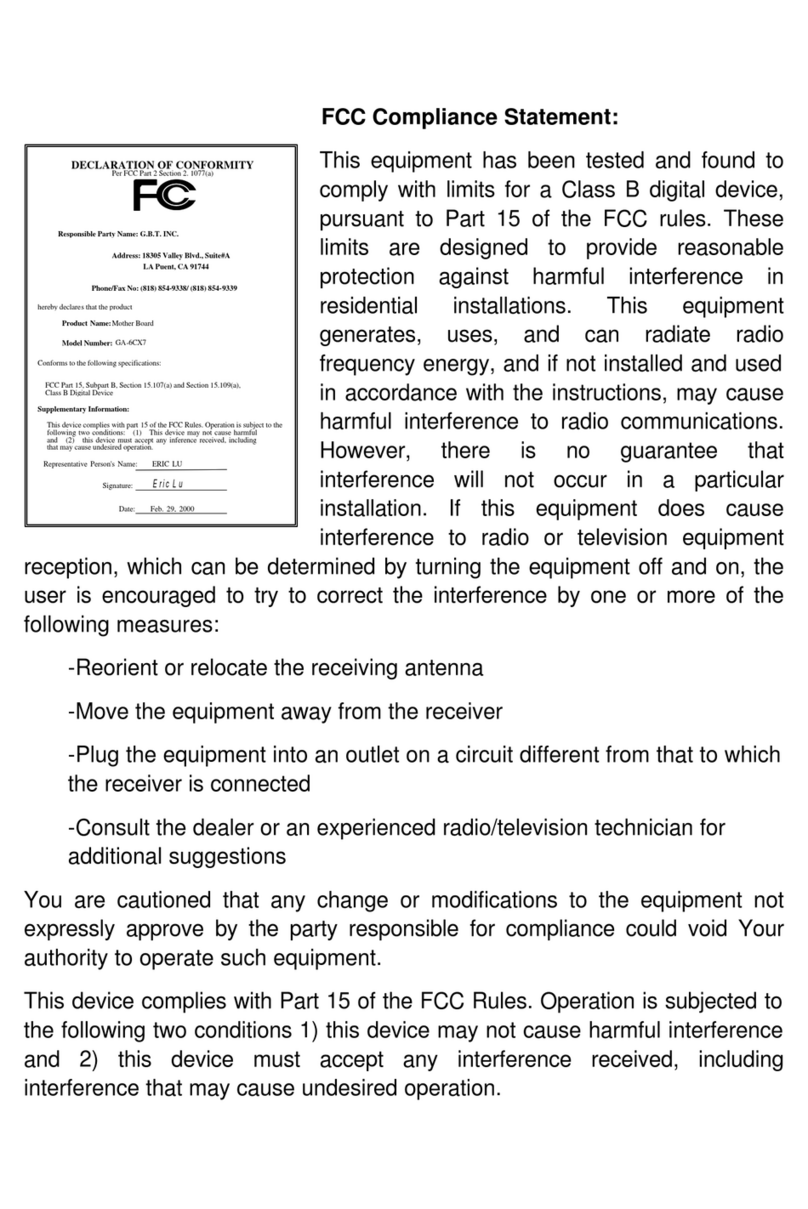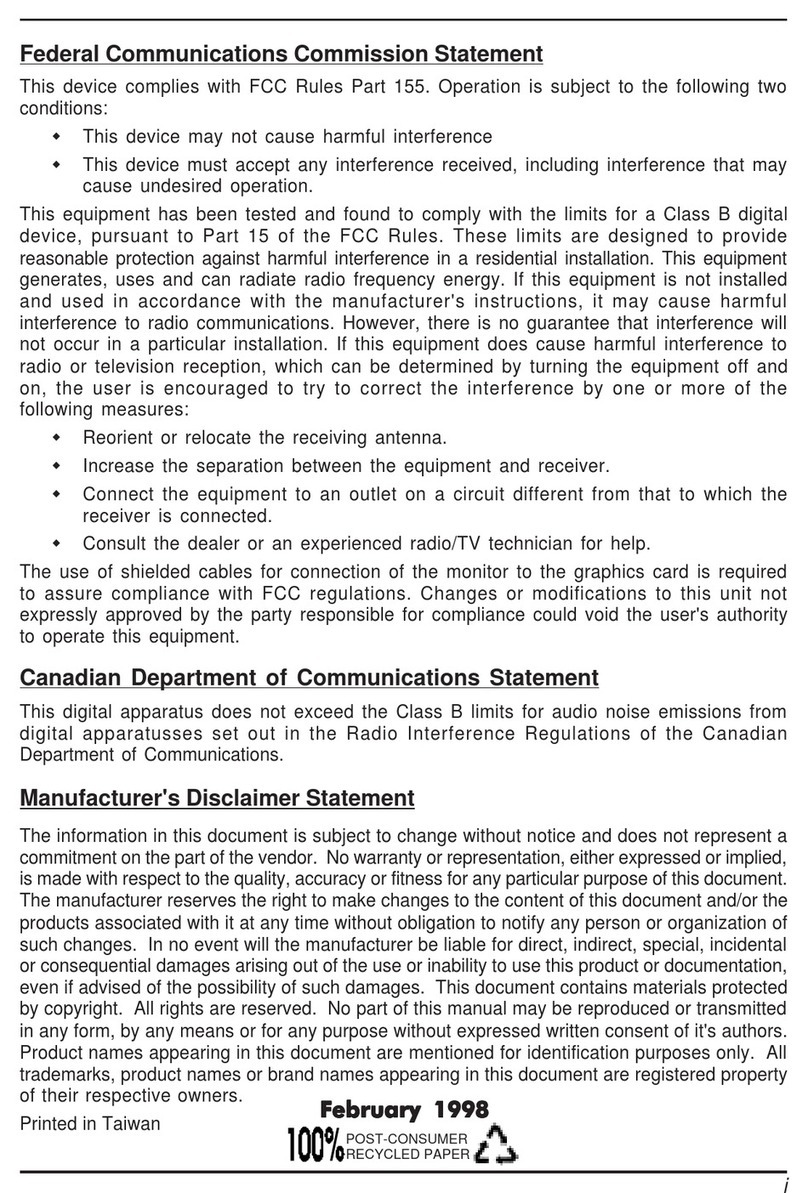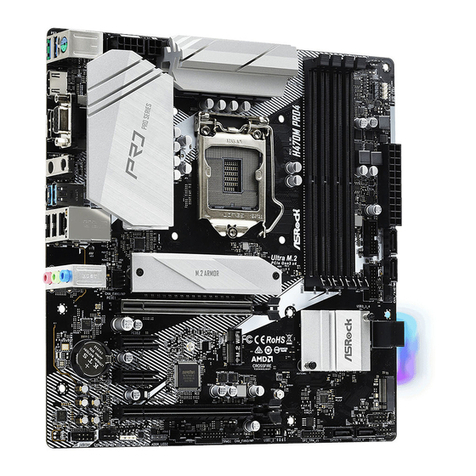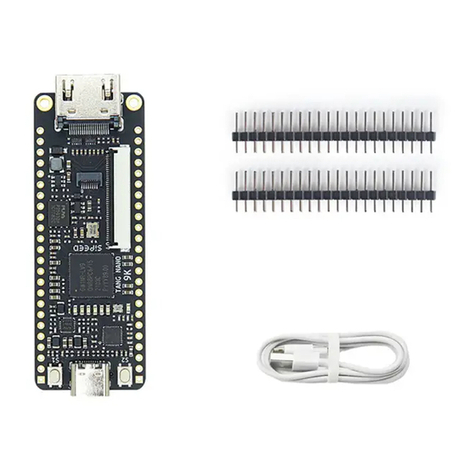IEPC EPC9034 User manual

Development Board
EPC9034
Quick Start Guide
80 V Half-bridge with Gate Drive, Using EPC2021
Revision 2.0

QUICK START GUIDE
EPC – THE LEADER IN GaN TECHNOLOGY | WWW.EPC-CO.COM | COPYRIGHT 2019 | | 2
EPC9034
QUICK START PROCEDURE
The half bridge development board EPC9034 is easy to set up as buck or
boost converter. Refer to gure 2 for buck converter conguration and
measurement setup, and gure 3 for boost converter setup, and follow the
procedure below:
Buck converter conguration
1. With power o, connect the input power supply bus to VIN (J5, J6) and
ground / return to GND.
2. With power o, connect the switch node (SW) of the half bridge to your
circuit as required (half bridge conguration). Or use the provided pads
for inductor (L1) and output capacitors (Cout), as shown in gure 2 with a
DC load connected across VOUT and GND.
3. With power o, connect the gate drive supply to VDD (J1, Pin-1) and
ground return to GND (J1, Pin-2 indicated on the bottom side of the
board).
4. With power o, connect the input PWM control signal to PWM1 (J2,
Pin-1) and ground return to any of GND J2 pins indicated on the bottom
side of the board.
5. Turn on the gate drive supply – make sure the supply is between 7.5 V
and 12 V.
6. Turn on the controller / PWM input source.
7. Making sure the intial input supply voltage is 0 V, turn on the power
and slowly increase the voltage to the required value (do not exceed
the absolute maximum voltage). Probe switching node to see switching
operation.
8. Once operational, adjust the PWM control, bus voltage, and load within
the operating range and observe the output switching behavior,
eciency and other parameters.
9. For shutdown, please follow steps in reverse.
EPC9034 development board
Front view
Table 1: Performance Summary (TA= 25°C) EPC9034
Symbol Parameter Conditions Min Max Units
VDD Gate Drive Input Supply Range 7 12 V
VIN Bus Input Voltage Range(1) 64(1) V
IOUT Switch Node Output Current (2) 35(2) A
VPWM
PWM Logic Input Voltage
Threshold
Input ‘High’
Input ‘Low’
3.5
0
6
1.5
V
V
VSW Switch-node Voltage
64(1)
Minimum ‘High’ State Input
Pulse Width
VPWM rise and fall
time < 10ns 50 ns
Minimum ‘Low’ State Input
Pulse Width (3)
VPWM rise and fall
time < 10ns 100(3) ns
(1) Maximum input voltage depends on inductive loading, maximum switch node ringing
must be kept under 80 V for EPC2021.
(2) Maximum current depends on die temperature – actual maximum current with be
subject to switching frequency, bus voltage and thermal cooling.
(3) Limited by time needed to ‘refresh’ high side bootstrap supply voltage.
DESCRIPTION
The EPC9034 development board is a 80 V maximum device voltage, 35 A
maximum output current, half bridge with onboard gate drives, featuring
the EPC2021 enhancement mode (eGaN®) eld eect transistor (FET).
The purpose of this development board is to simplify the evaluation
process of the EPC2021 eGaN FET by including all the critical components
on a single board that can be easily connected into the majority of
existing converter topologies.
The EPC9034 development board measures 2” x 2” and contains two
EPC2021 eGaN FETs in a half bridge conguration using the Texas
Instruments LMG1205 gate driver. The board also contains all critical
components and the layout supports optimal switching performance.
There are also various probe points to facilitate simple waveform
measurement and eciency calculation. A block diagram of the circuit
is given in gure 1.
For more information on the EPC2021 please refer to the datasheet
available from EPC at www.epc-co.com. The datasheet should be read in
conjunction with this quick start guide.
Back view

QUICK START GUIDE
EPC – THE LEADER IN GaN TECHNOLOGY | WWW.EPC-CO.COM | COPYRIGHT 2019 | | 3
EPC9034
Figure 2: Buck conguration
Figure 3: Boost conguration
Figure 1: Block diagram of EPC9034 development board
7.5 – 12 VDC
32 VDCmax
VDD supply
(Note polarity) VMain supply
(Note polarity)
Output Capacitor Output Inductor
Main voltage measurement
(HIGH VOLTAGE!)
DC load
Dead-time adjust
Control
signal
inputs
+
+
V
Boost Converter conguration
Warning: Never operate the boost converter mode without a load
as the output voltage can increase beyond the maximum ratings.
1. The inductor (L1) and input capacitors (labeled as Cout) can
either be soldered onto the board, as shown in gure 3, or
provided o board. Anti-parallel diodes can also be installed
using the additional pads on the right side of the EPC2021
FETs.
2. With power o, connect the input power supply bus to VOUT
(J9, Pin-1) and ground / return to GND (J9, Pin-2), or externally
across the capacitor if the inductor L1and Cout are provided
externally. Connect the output voltage (labeled as VIN, J5, J6)
to your circuit as required, e.g., resistive load.
3. With power o, connect the gate drive supply to VDD (J1,
Pin-1) and ground return to GND (J1, Pin-2 indicated on the
bottom side of the board).
4. With power o, connect the input PWM control signal to
PWM1 (J2, Pin-1) and ground return to any of GND J2 pins
indicated on the bottom side of the board. Note that the
bottom FET gate drive signal is inverted with regard to
PWM1. It is also possible to use separate input PWM signals
by removing R2 and R17 and installing 0 Ω jumpers for R14
and R16.
5. Turn on the gate drive supply – make sure the supply is
between 7.5 V and 12 V.
6. Turn on the controller / PWM input source.
7. Making sure the output is not open circuit, and the input
supply voltage is initially 0 V, turn on the power and slowly
increase the voltage to the required value (do not exceed
the absolute maximum voltage). Probe switching node to
see switching operation.
8. Once operational, adjust the PWM control, bus voltage, and
load within the operating range and observe the output
switching behavior, eciency and other parameters.
Observe device temperature for operational limits.
9. For shutdown, please follow steps in reverse.
7.5 – 12 V
DC
VDD supply
(Note polarity)
Input Capacitor
Input Inductor
Dead-time adjust
Control
signal
inputs
+
32 VDCmax
DC load
VMain supply
(Note polarity)
+
Level shift
VDD
VIN
Q1
Q2
CBypass
PWM
GND
Gate drive
regulator
Gate driver
Output
PGND
Logic and
dead-time
adjust

QUICK START GUIDE
EPC – THE LEADER IN GaN TECHNOLOGY | WWW.EPC-CO.COM | COPYRIGHT 2019 | | 4
EPC9034
Figure 4: Measurement top side
Figure 5: Measurement bottom side.
Q1gate MMCX
(HIGH VOLTAGE!)
Ground oscilloscope probe
Switch-node oscilloscope probe
Q2gate
Ground
Voltage measurement:
Input voltage for Buck,
Output voltage for Boost
(HIGH VOLTAGE!)
Switch-node
output
V
Q2gate MMCX
THERMAL CONSIDERATIONS
The EPC9034 development board showcases the
EPC2021 eGaN FET. The EPC9034 is intended for
bench evaluation with low ambient temperature
and convection cooling. The addition of heat-sinking
and forced air cooling can signicantly increase
the current rating of these devices, but care must
be taken to not exceed the absolute maximum die
temperature of 150° C.
NOTE. The EPC9034 development board does not have any
current or thermal protection on board. For more information
regarding the thermal performance of EPC eGaN FETs, please
consult:
D. Reusch and J. Glaser, DC-DC Converter Handbook, a
supplement to GaN Transistors for Ecient Power Conversion,
First Edition, Power Conversion Publications, 2015.
MEASUREMENT CONSIDERATIONS
When measuring the high frequency content switch
node, care must be taken to provide an accurate high
speed measurement. An optional two pin header
(J10) is included for switch node measurement.
MMCX connector footprint is also provided (J15 in
gure 5) to measure switch node.
Low-side gate voltage (VGS2) can be measured at the
two pin header (J22) or the MMCX (J12). Please refer
to gure 4. R7 (0 Ω resistor) will need to be installed.
High-side gate voltage (VGS1) can only be measured
using the MMCX connector (J11). Please refer to
gure 4. R6 (0 Ω resistor) will need to be installed.
Dierential probe is recommended for measuring
high-side gate. IsoVu probes from Tektronix has
mating MMCX connector.
For regulator passive voltage probes (e.g. TPP1000)
measuring low-side gate or switch node using
MMCX connector, probe adaptor is available. PN:
206-0663-xx.
NOTE. For information about measurement techniques,
the EPC website oers: “AN023 Accurately Measuring
High Speed GaN Transistors” and the How to GaN
educational video series, including: HTG09-Measurement
Ground oscilloscope probe
Switch-node oscilloscope probe
Switch-node MMCX

EPC – THE LEADER IN GaN TECHNOLOGY | WWW.EPC-CO.COM | COPYRIGHT 2019 | | 5
QUICK START GUIDE EPC9034
Table 2: Bill of Materials
Item Qty Reference Part Description Manufacturer Part Number
1 3 C4, C10, C11 Capacitor, 1 µF, ±10%, 25 V X7R TDK C1608X7R1E105K
2 2 C5, C6 Capacitor, 0.1 µF, ±10%, 25 V X7R TDK C1608X7R1E104K
3 1 C9 Capacitor, 0.1 µF, ±10%, 25 V X7R Yageo CC0402KRX7R8BB104
4 2 C12, C14 Capacitor, 0.1 µF, ±10%, 16 V X7R Murata GRM155R71C104KA88D
5 1 C15 Capacitor, 0.022 µF, ±10%, 25 V X7R TDK C1005X7R1E223K050BB
6 2 C16, C17 Capacitor, 100 pF, ±10%, 50 V X7R Yageo CC0402KRX7R9BB101
7 1 C20 Capacitor, 4.7 µF, ±10%, 10 V X5R TDK C1005X5R1A475K050BC
8 10 C21, C22, C23, C24, C25,
C26, C34, C35, C36, C37 Capacitor, 1 µF, ±20%, 100 V X7S TDK C2012X7S2A105M125AB
9 7 C27, C28, C29, C30,C31,
C32, C33 Capacitor, 0.22 µF, ±10%, 100 V X7S Taiyo Yuden HMK107C7224
10 4 D1, D2, D5, D6 Schottky Diode, 30 V 30 mA Diodes Inc. SDM03U40
11 1 D4 Zener Diode, 5.1 V, 150 mW, ±5% Bournes CD0603-Z5V1
12 1 U2 100 V eGaN Driver TI LMG1205YFXR
13 2 Q1, Q2 eGaN FET, 80 V, 2.5 mΩ EPC EPC2021
14 1 Q3 eGaN FET, 100 V, 3300 mΩ EPC EPC2038
15 2 R1, R15 Resistor, 10 kΩ, ±5%, 1/10 W Yageo RC0603JR-0710KL
16 3 R2, R3, R17 Resistor, 0.0 Ω, 1/16 W Stackpole RMCF0603ZT0R00
17 1 R4 Resistor, 10 Ω, ±1%, 1/10 W Panasonic ERJ-3EKF10R0V
18 1 R5 Resistor, 100 Ω, ±1% 0.1 W, 1/10 W Panasonic ERJ-3EKF1000V
19 1 R9 Resistor, 0 Ω Jumper 0.063 W, 1/16 W Stackpole RMCF0402ZT0R00
20 2 R19, R21 Resistor, 2.7 Ω, ±5% 0.1 W, 1/10 W Panasonic ERJ-2GEJ2R7X
21 2 R20, R22 Resistor, 500 mΩ, ±1% 0.125 W, 1/8 W Stackpole PT0402FR-7W0R5L
22 1 R24 Resistor, 27 kΩ, ±5% 0.1 W, 1/10 W Panasonic ERJ-2GEJ273X
23 1 R25 Resistor, 20 Ω, ±5% 0.063 W, 1/16 W Stackpole RMCF0402JT20R0
24 1 U3 I.C., Regulator Microchip MCP1703T-5002E/MC
25 1 U1 I.C., Logic Fairchild NC7SZ00L6X
26 1 U4 I.C., Logic Fairchild NC7SZ08L6X
27 2 J1, J22 Connector Würth 61300211121
28 2 J2, J3 Connector Tyco 4-103185-0-04
29 2 TP1, TP2 SMT test point Keystone 5015
Optional Components
Item Qty Reference Part Description Manufacturer Part Number
1 DNP Cout TBD Generic Generic
2 DNP D3 Schottky Diode, 40 V 300 mA ST BAT54KFILM
3 DNP D7, D8 Schottky Diode, 100 V 2A Vishay SS2PH10-M3
4 DNP L1 Inductor - TBD Generic Generic
5 DNP P1, P2 Potentiometer, 1 kΩ 0.25 W, 1/4 W Murata PV37W102C01B00
6 DNP R10, R14, R16 Resistor, 0 Ω Jumper 0.1 W, 1/10 W Stackpole RMCF0603ZT0R00
7 DNP R6, R7 Resistor, 0 Ω Jumper 0.063 W, 1/16 W Stackpole RMCF0402ZT0R00
8 DNP R18 Resistor, 4.7 Ω, ±5% 0.1 W, 1/10 W Panasonic ERJ-2GEJ4R7X
9 DNP J9 7.62 mm Euro Term. Würth 691216410002
10 DNP J10 .1" Male Vert. Würth 61300211121
11 DNP J11, J12, J15 Connector Molex 0734152063

QUICK START GUIDE
EPC – THE LEADER IN GaN TECHNOLOGY | WWW.EPC-CO.COM | COPYRIGHT 2019 | | 6
EPC9034
Figure 6: EPC9034 - Schematic
U2
uP1966A
.1" Male Vert.
J1
7.5 VDC - 12 VDC
V7in
Logic Supply
V7in IN
GND
U3
MCP1703T-5002E/MC
1 μF, 25 V
C10 1 μF, 25 V
C4
1 μF, 25 V
C11
Logic Supply Regulator
0 Ω
R3
VCC
P1 EMPTY
TBD
2
R4
HIN
D2
SDM03U40
VCC
Deadtime Lower
A
B
U1
NC7SZ00L6X
LIN
PWM2 PWM1 P2 EMPTY
PWM2
.1" Male Vert.
J2
PWM1
PWM2
100 pF, 50 V
C16
100 pF, 50 V
C17
2.7 Ω R19
R20 0.5 Ω
R21 2.7 Ω
R22 0.5 Ω
VSW
LIN
HIN
0.1 μF, 25 V
C9
TBD
Cout
1 μF, 100 V
C21
vSW probe holes
L1 TBD
EMPTY
VSW
SW Output
Main Supply Input
GND
Sync Buck Output
0 Ω
R6
VG1 EMPTY 1
2
J11
EMPTY
1
2
J12
EMPTY
1
TP2
TP1
2
1
J10
EMPTY
VG2
MMCX
vGS1 probe adapter
MMCX
vGS2 probe
adapter
4.7 V
VG2
Synchronous Boostrap Power Supply
Gbtst
20 Ω
1
R25
SDM03U40
40 V 30 mA
D5
100 nF, 16 V
C14
CD0603-Z5V1
5V1, 150 mW
D4
SDM03U40
40 V 30 mA
D6
22 nF, 25V
C15
27 k
1
R24
4.7 Ω
2R18
EMPTY
100 nF, 16 V
C12
VCC
BAT54KFILM
40 V 300 mA
D3
EMPTY
4.7 μF, 10 V
C20
VSW
VG1
VG2
4.7 V
0 Ω
R9
VG1
VCC
VCC
5VHS1
VSW
100 V 2800 mΩ
EPC2038
Q3
5VHS1
VSW
220 nF, 100 V
C27
220 nF, 100 V
C28
220 nF, 100 V
C29
220 nF, 100 V
C30
220 nF, 100 V
C31
VSW
4.7 V
1 μF, 100 V
C22
1 μF, 100 V
C23
1 μF, 100 V
C24
SS2PH10-M3
100 V, 2 A
D8
EMPTY
D1
SDM03U40
100 nF, 25 V
C5
10 k
1
R1
Deadtime Upper
A
B
U4
NC7SZ08L6X
PWM1 PWM1
0 Ω
R16 2
EMPTY
PWM1
0 Ω 2
R17
VCC
100 nF, 25 V
C6
VCC10 k
1
R15
0 Ω 2
R2
TBD
2
R5
0 Ω
R14 2
EMPTY
0 Ω
R10
EMPTY
VCC
Direct Drive
Direct Drive
Ext. Regulator
Int. Regulator
V7in
220 nF, 100 V
C32
220 nF, 100 V
C33
1 μF, 100 V
C25
1 μF, 100 V
C26
1 μF, 100 V
C34
1 μF, 100 V
C35
1 μF, 100 V
C36
1 μF, 100 V
C37
7.62 mm Euro Term.
1
2
J9
EMPTY
0 Ω
R7
EMPTY
.1" Male Vert.
2
1
J22
VSW
vSW probe adapter
1
2
J15
EMPTY
MMCX
VG2 SS2PH10-M3
100 V, 2 A
D7
EMPTY
1
2
3
4
5
6
7
8
J3A
9
10
11
12
13
14
15
16
J3B
17
18
19
20
21
22
23
24
J3C
Q1
EPC2021
Q2
EPC2021
VOUT VOUT
VOUT
VIN
VIN
VIN
VLDO

Demonstration Board Notication
The EPC9034 board is intended for product evaluation purposes only. It is not intended for commercial use nor is it FCC approved for resale. Replace components on the
Evaluation Board only with those parts shown on the parts list (or Bill of Materials) in the Quick Start Guide. Contact an authorized EPC representative with any questions. This board is
intended to be used by certied professionals, in a lab environment, following proper safety procedures. Use at your own risk.
As an evaluation tool, this board is not designed for compliance with the European Union directive on electromagnetic compatibility or any other such directives or regulations. As board
buildsare at times subject toproduct availability, it is possible thatboardsmay containcomponentsor assemblymaterials that arenot RoHScompliant.EcientPowerConversionCorpora-
tion (EPC) makes no guarantee that the purchased board is 100% RoHS compliant.
The Evaluation board (or kit) is for demonstration purposes only and neither the Board nor this Quick Start Guide constitute a sales contract or create any kind of warranty, whether express
or implied, as to the applications or products involved.
Disclaimer: EPC reserves theright at any time, without notice, tomakechanges toany products described hereinto improvereliability, function, or design. EPC doesnot assume any liability
arising out of the application or use of any product or circuit described herein; neither does it convey any license under its patent rights, or other intellectual property whatsoever, nor the
rights of others.
EPC Products are distributed through Digi-Key.
www.digikey.com
For More Information:
or your local sales representative
Visit our website:
www.epc-co.com
Sign-up to receive
EPC updates at
bit.ly/EPCupdates
or text“EPC”to 22828
Table of contents
Other IEPC Motherboard manuals
